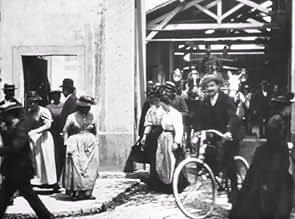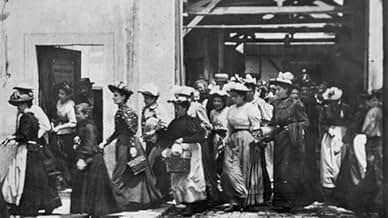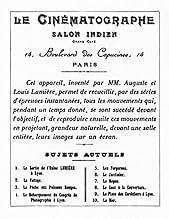La salida de la fábrica Lumière en Lyon
Título original: La sortie de l'usine Lumière à Lyon
PUNTUACIÓN EN IMDb
6,8/10
8 mil
TU PUNTUACIÓN
Trabajadores saliendo de la fábrica Lumière para comer en Lyon, Francia, en 1895. Un lugar de gran innovación fotográfica y uno de los lugares de nacimiento del cine.Trabajadores saliendo de la fábrica Lumière para comer en Lyon, Francia, en 1895. Un lugar de gran innovación fotográfica y uno de los lugares de nacimiento del cine.Trabajadores saliendo de la fábrica Lumière para comer en Lyon, Francia, en 1895. Un lugar de gran innovación fotográfica y uno de los lugares de nacimiento del cine.
- Dirección
Reseñas destacadas
This is it!! if your looking for a thrilling few minutes of the French leaving work then it does not get any better than this.Action to look out for includes,
French woman walking at the screen, French bloke wobbling on his bike, The closing of the gates cliff-hanger Finale.
Oh and its maybe the most important few minutes in the history of cinema.
French woman walking at the screen, French bloke wobbling on his bike, The closing of the gates cliff-hanger Finale.
Oh and its maybe the most important few minutes in the history of cinema.
10jhaugh
All films made before 1912 really need to be viewed with a sense of time and place.
In 1894, the Lumiere-family men [father: Antoine (1840-1911), sons: Auguste and Louis] owned and managed a factory that manufactured photographic plates and paper. Not a small enterprise; the factory had more than 200 employees who received pension and social security benefits - innovative for that time. It was located at Montplaisir in the suburbs of Lyon, France. What caused Louis Lumiere to become interested in building a Cinematagraph, in 1894, remains open for speculation. My suggestion is that the appearance of the Edison organization's Kinetoscope (peep-show machine), in Paris during the fall of 1894, provided the catalyst.
W.K.L. Dickson, of Edison's staff, invented a motion-picture camera about the size of an upright piano that was patented in February 1893. It was electrically operated (using power from from heavy storage batteries. This massive machine pumped celluloid film strip (newly developed by the Eastman company) past a lens at about 40 frames-per-second (fps). It was ensconced, as an almost immovable object, in the "Black Maria" (essentially the first movie studio.) The Kinetescope machines showed staged presentations (less than one-minute long)that were filmed in this studio.
During 1894, Louis Lumiere applied himself to the task of inventing a moving-picture camera. He had determined that, even at 16 fps on celluloid film, the persistence-of-vision of the human eye/brain would allow for normal motion to be perceived. His camera, dubbed the Cinematograph, was about the size of a large shoe box and was provided with a detachable film magazine that provided storage for enough film to make a shoot last about one minute when it was had cranked past the lens at 16 fps.
The size and light weight, of the camera (it could be converted into a printer or a projector by the addition of a light source) made it portable enough that it could be taken to any location to record an event (provided there was enough sunlight available.) In the spring of 1895, Louis filmed: trick-riding by some cavalry men; a house on fire with firemen arriving and dousing the engulfed building with water; and a number of other scenes in and around Lyon. Using a Molteni bulb, he turned the camera into a projector and presented his films to scientists assembled in the reception room of the Revue Generales des Science. The images were projected on a screen five-meters distant from the lens. The screen was stretched in a doorway between two rooms. At a meeting of professional photographers, that same year, Louis photographed the arriving delegates and the same evening showed them motion pictures of their arrival.
With accolades from both the scientific and photographic communities, Louis decided to have a public exhibition of his invention by the end of the year. Since each of his films would be about one-minute long, he would need at least a dozen films to make a good presentation. For one of these films he set up his camera at the entrance to his factory, photographing the egress of employees at quitting-time.
The public venue chosen by Antoine - who offered himself as the "fairground barker" for the Cinematograph - was the Salon Indien of the Grand Cafe on the boulevard des Capucines in Paris. It was a wintry Saturday night on 28 December, 1895. As the first audience sat, they were presented with a projected view of the exterior of the Lumiere factory (with closed gates.) Some were chagrined that they were just going to see a routine slide show of Lumiere photographs. But then the crank on the camera/projector was turned and movement began. Louis had an innate sense for motion picture taking. This film has a beginning, a middle and an end. In the beginning, the doors are opened and people begin to leave their workplace; during the middle, the people stream out - with many trying to ignore the camera, and the cameraman, as they seem to be happy to leave a day of labor behind them. At the end, the gates to the factory are being closed.
And this was the first film projected for the entertainment of the general public.
In 1894, the Lumiere-family men [father: Antoine (1840-1911), sons: Auguste and Louis] owned and managed a factory that manufactured photographic plates and paper. Not a small enterprise; the factory had more than 200 employees who received pension and social security benefits - innovative for that time. It was located at Montplaisir in the suburbs of Lyon, France. What caused Louis Lumiere to become interested in building a Cinematagraph, in 1894, remains open for speculation. My suggestion is that the appearance of the Edison organization's Kinetoscope (peep-show machine), in Paris during the fall of 1894, provided the catalyst.
W.K.L. Dickson, of Edison's staff, invented a motion-picture camera about the size of an upright piano that was patented in February 1893. It was electrically operated (using power from from heavy storage batteries. This massive machine pumped celluloid film strip (newly developed by the Eastman company) past a lens at about 40 frames-per-second (fps). It was ensconced, as an almost immovable object, in the "Black Maria" (essentially the first movie studio.) The Kinetescope machines showed staged presentations (less than one-minute long)that were filmed in this studio.
During 1894, Louis Lumiere applied himself to the task of inventing a moving-picture camera. He had determined that, even at 16 fps on celluloid film, the persistence-of-vision of the human eye/brain would allow for normal motion to be perceived. His camera, dubbed the Cinematograph, was about the size of a large shoe box and was provided with a detachable film magazine that provided storage for enough film to make a shoot last about one minute when it was had cranked past the lens at 16 fps.
The size and light weight, of the camera (it could be converted into a printer or a projector by the addition of a light source) made it portable enough that it could be taken to any location to record an event (provided there was enough sunlight available.) In the spring of 1895, Louis filmed: trick-riding by some cavalry men; a house on fire with firemen arriving and dousing the engulfed building with water; and a number of other scenes in and around Lyon. Using a Molteni bulb, he turned the camera into a projector and presented his films to scientists assembled in the reception room of the Revue Generales des Science. The images were projected on a screen five-meters distant from the lens. The screen was stretched in a doorway between two rooms. At a meeting of professional photographers, that same year, Louis photographed the arriving delegates and the same evening showed them motion pictures of their arrival.
With accolades from both the scientific and photographic communities, Louis decided to have a public exhibition of his invention by the end of the year. Since each of his films would be about one-minute long, he would need at least a dozen films to make a good presentation. For one of these films he set up his camera at the entrance to his factory, photographing the egress of employees at quitting-time.
The public venue chosen by Antoine - who offered himself as the "fairground barker" for the Cinematograph - was the Salon Indien of the Grand Cafe on the boulevard des Capucines in Paris. It was a wintry Saturday night on 28 December, 1895. As the first audience sat, they were presented with a projected view of the exterior of the Lumiere factory (with closed gates.) Some were chagrined that they were just going to see a routine slide show of Lumiere photographs. But then the crank on the camera/projector was turned and movement began. Louis had an innate sense for motion picture taking. This film has a beginning, a middle and an end. In the beginning, the doors are opened and people begin to leave their workplace; during the middle, the people stream out - with many trying to ignore the camera, and the cameraman, as they seem to be happy to leave a day of labor behind them. At the end, the gates to the factory are being closed.
And this was the first film projected for the entertainment of the general public.
Forget the "twists" you've seen in films like Psycho (1960), The Sixth Sense(1999), and the Crying Game(1992), LEAVING THE LUMIERE FACTORY (1895) blows those plot points out of the water and takes it rightful place as the biggest shock in movie history.
December 28, 1895, The Grand Cafe' in Paris, France. Only 33 out of 100 tickets are sold to the first ever demonstration of the Lumiere Cinematograph. A jaded, French crowd sits in the theater waiting to see this mystery invention they know nothing about. The lights go down. A static, barren shot of the front door of a factory is projected onto the screen. Several seconds go by before a man stands up and shouts in disappointment, "It's just the old Magic Lantern!" (the magic lantern was a primitive slide projector for still photographs) Suddenly, the doors of the factory on screen miraculously swing open, a crowd of women pour out into the frame and a seizure of--believe it or not!--motion happens within the picture. Needless to say, the audience was caught completely off guard, and were absolutely dumbstruck.
Can you imagine it?! The audience had co clue that the picture would move! They must have went bonkers! It would be like you watching Jerry Maguire, and then Tom Cruise walks right out of the screen and sits down next to you!
When those French ladies opened the doors to the Lumiere Factory, they were also opening the doors to a whole new world of art and entertainment!
December 28, 1895, The Grand Cafe' in Paris, France. Only 33 out of 100 tickets are sold to the first ever demonstration of the Lumiere Cinematograph. A jaded, French crowd sits in the theater waiting to see this mystery invention they know nothing about. The lights go down. A static, barren shot of the front door of a factory is projected onto the screen. Several seconds go by before a man stands up and shouts in disappointment, "It's just the old Magic Lantern!" (the magic lantern was a primitive slide projector for still photographs) Suddenly, the doors of the factory on screen miraculously swing open, a crowd of women pour out into the frame and a seizure of--believe it or not!--motion happens within the picture. Needless to say, the audience was caught completely off guard, and were absolutely dumbstruck.
Can you imagine it?! The audience had co clue that the picture would move! They must have went bonkers! It would be like you watching Jerry Maguire, and then Tom Cruise walks right out of the screen and sits down next to you!
When those French ladies opened the doors to the Lumiere Factory, they were also opening the doors to a whole new world of art and entertainment!
This one-minute film is arguably the first movie ever made. Other inventors had previously filmed actions - like Edison's motion photography of a sneeze - but the Lumiere brothers developed equipment that tremendously advanced the medium. At the time, of course, their `cinematograph' must have bewildered their peers, including their subjects. In this first instance, the brothers record employees leaving their factory, some of whom understandably struggle to hide their awareness of the camera. The Lumieres attempt to make the film more entertaining by introducing animals and a bicycle, but `La Sortie Des Usines Lumiere' doesn't nearly match the ingenuity of their later films. The most interesting aspect of this short film is the brothers' selection of a familiar working class ritual as their subject. Their choice is the initial evidence of their curiosity about all of the world's people, a quality that makes viewing their experiments immensely rewarding and fascinating today.
Rating: 8
Rating: 8
On the 28th of December, 1895, in the Grand Café in Paris, film history was writing itself while Louis Lumière showed his short films, all single shots, to a paying audience. 'La Sortie des Usines Lumière' was the first film to be played and I wish I was there, not only to see the film, but also the reactions of the audience.
We start with closed doors of the Lumière factory. Apparently, since the image seems a photograph, people thought they were just going to see a slide show, not something they were hoping for. But then the doors open and people are streaming out, heading home. First a lot of women, then some men, and one man on a bike with a big dog. When they are all out the doors close again.
Whether this is the first film or not (some say 'L'Arrivée d'un Train à la Ciotat' was the first film Lumière recorded), it is an impressive piece of early cinema. Being bored by this is close to impossible for multiple reasons. One simple reason: it is only fifty seconds long. But also for people who normally only like the special effect films there must be something interesting here; you don't get to see historical things like this every day.
We start with closed doors of the Lumière factory. Apparently, since the image seems a photograph, people thought they were just going to see a slide show, not something they were hoping for. But then the doors open and people are streaming out, heading home. First a lot of women, then some men, and one man on a bike with a big dog. When they are all out the doors close again.
Whether this is the first film or not (some say 'L'Arrivée d'un Train à la Ciotat' was the first film Lumière recorded), it is an impressive piece of early cinema. Being bored by this is close to impossible for multiple reasons. One simple reason: it is only fifty seconds long. But also for people who normally only like the special effect films there must be something interesting here; you don't get to see historical things like this every day.
¿Sabías que...?
- CuriosidadesIt was the first film ever to be projected to a paying audience.
- Versiones alternativasThree versions of the film exist. There are a number of differences between them, such as the clothing styles worn by the workers change to reflect the different seasons the versions were shot in, and the horse-drawn carriage that appears in the first version is pulled by one horse, two horses in the second version, and no horse and no carriage in the third version.
- ConexionesEdited into The Lumière Brothers' First Films (1996)
Selecciones populares
Inicia sesión para calificar y añadir a tu lista para recibir recomendaciones personalizadas
Detalles
- Fecha de lanzamiento
- País de origen
- Sitios oficiales
- Idioma
- Títulos en diferentes países
- Employees Leaving the Lumière Factory
- Localizaciones del rodaje
- Empresa productora
- Ver más compañías en los créditos en IMDbPro
- Duración
- 1min
- Color
- Mezcla de sonido
- Relación de aspecto
- 1.33 : 1
Contribuir a esta página
Sugerir un cambio o añadir el contenido que falta




















